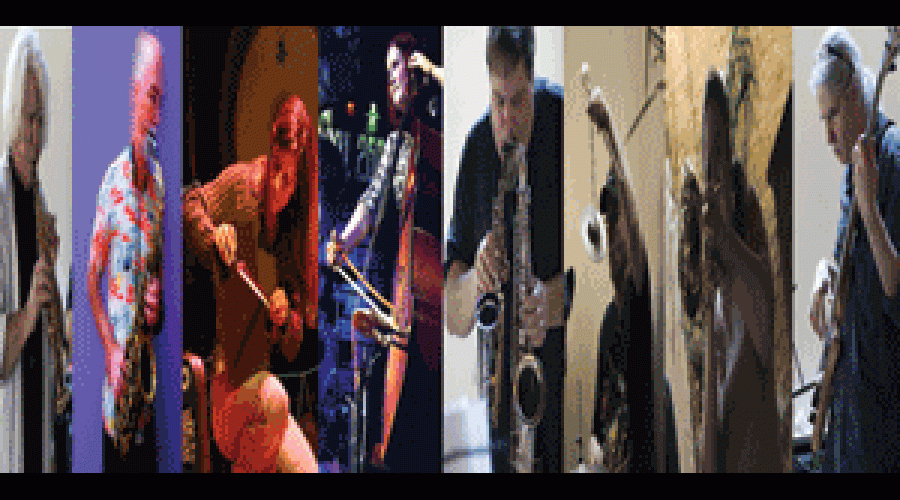Archive
CNMAT Flashback
A look back at some items in our archives.
BAASICS2: The Future
Open Sound West Presents: Golia, Adams, Stackpole, Mezzacappa Meeting and Lords of Outland
Archive Browser
Jeudi Laboratoire
##Exercise :
- réalisation d’un "sampler" polyrhythmique
#Patches fourni :
- "simple-sampler~" : une abstraction qui joue un échantillon à la fois en utilisant l'objet play~. Voir aussi le fichier d'aide fourni.
- "percussion-buffers" : un patch qui lit neuf fichiers-sons dans neuf objets buffer~.
#À faire :
3 - Samedi: Travailler avec les résonances
#Sujets :
+ Outils spectraux d'analyse et de (re)synthèse du CNMAT
- la synthèse additive et soustractive
- introduction au format SDIF
- les modèles de résonance
- modifier les modèles
#Objets :
- sinusoids~, resonators~
- SDIF-buffer, SDIF-tuples
- res-trasnform, resonance-display.js
#Exercice:
- réalisation de résonateurs polyrhythmiques
4 - Dimanche: Réaliser de la musique
#Sujets:
- Construction d'un patch pour le concert
- exemples de patches du CNMAT et CIRM (A. Einbond, J. MacCallum, E. Campion, F. Paris)
#Exercice:
- construction d'un patch simple à partir des idées et des systèmes de contrôles proposés par les stagiaires
+ quelques suggestions :
- faire un patch pour déclencher un "freeze" résonant à partir d'un signal audio.
Links, Materials, Downloads
##Télécharger
- Avant de commencer, téléchargez tous les outils de CNMAT ici sous "Everything" : [cnmat:downloads|CNMAT Downloads].
À revoir souvent -- la dernière mise à jour était en janvier 2009!
Accessing the Windows machine (PEROTIN)
The Windows machine is now in the machine room (small studio) downstairs and can be accessed via VNC. The address is 128.32.122.182 and the password is on a piece of tape stuck to the machine.
Subversion Directory Structure
Subversion Directory Structure
CNMAT uses Subversion for version control. Inside our main repository (whose contents are documented [cnmat:node/2982|here]), there's a top-level directory called max with these subdirectories:
Directory layout of CNMAT's SVN repository
CNMAT doesn't currently use SVN branches, so everything in our SVN repository lives under the top-level directory __trunk__.
Currently (July 30, 2007) there are ten top-level directories in our repository:
- OSC: OpenSoundControl libraries, command-line utilities, and related software. (But not the OSC-related Max externals.)
0. How Subversion is laid out at CNMAT
(Note that although most of CNMAT's software development documentation is visible to the public, this particular page is restricted to certain internal CNMAT groups because it contains information about our internal organization that is irrelevant to people outside of CNMAT and potentially might compromise the security of our intellectual property.)
CNMAT Coding Conventions
CNMAT externals follow a few conventions:
CNMAT Software Development Documentation
Information about software development system and practices at CNMAT.
Music Information Center Tutorials
A collection of tutorials intended to guide students through various topics related to music performance, compositions, history, and more.
Gesture Controllers
Gesture controllers correspond human movement to machine readable data input.
Connecting a gesture controller to a computer
Gesture controllers can connect to computers in a variety of ways.
This page is a prototype page as part of the MIC.
USB-HID in Max/MSP
Using a USB-HID with Max/MSP is fairly straight forward. Follow the link to see how to connect and play with your USB-HID.
This page is part of a prototype page of the MIC.
Using the Wii Remote with Max/MSP
The accelerometer and IR sensor in the Wii remote make it a versatile and powerful gesture controller.
This page is part of a prototype page of the MIC.
2008 Max/MSP Night School: Syllabus and Patches
See below for for day by day break down...
Introduction: The electric guitar as a subject of study, the potential for music and musicology
Anne Sèdes - University of Paris 8 CICM
This introduction and welcome served mainly to help us understand who was at the conference and to reaffirm Anne's ambitions for
a higher visibility of the electric guitar as a valuable object of study for the humanities.
History and Organology of the Electric Guitar
Benoît Navarret - University of Paris 8 CICM
Benoît's wisely chose to focus on the history of the electric guitar with just enough organology to put everyone on the same page
Digital audio processing of the amplified electric guitar
Benoiît Courribet University of Paris 8 CICM
A second and (very different) Benoiît showed us his work exploring implementations of the classic analog effects using digital implementations in Max/MSP.
Guitar technology demonstrations
Benoît's Navarret and Courribet, Otso Lähdeoja and Santiago Quintans
The Gibson HD6X-pro, Robot Guitar and Line6 Variax 700 were demonstrated and discussed

